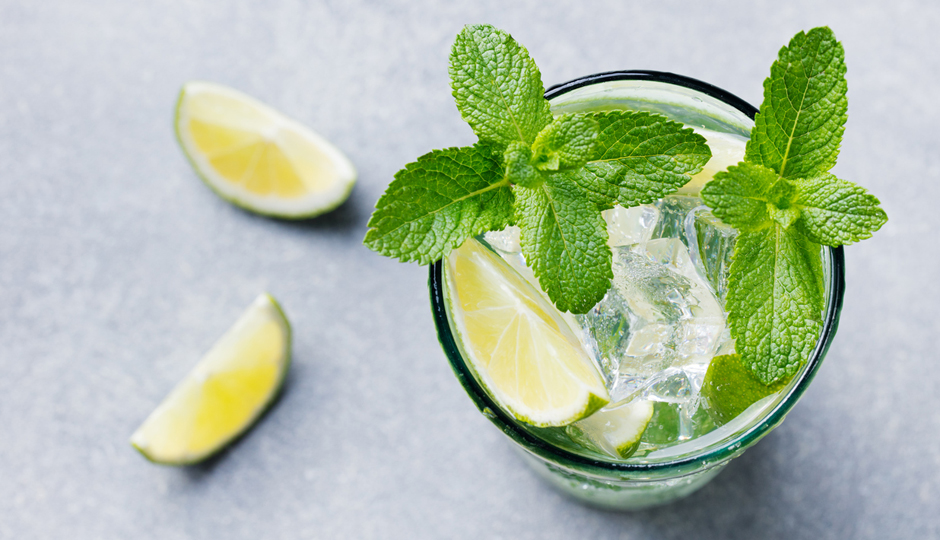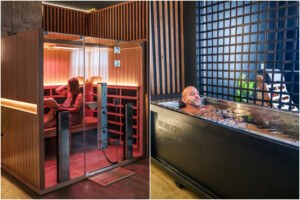The Dietitian’s Guide to Hacking Happy Hour (And Avoiding Pitfalls)
When you think of dietitians, you might think we all steer clear of alcohol at all costs. I am here to tell you, that is not the case. We, too, are human and like enjoying a drink here and there with our friends. And — while many of us are guilty of doing keg stands and nursing horrible hangovers the next day (we all have our moments, right?) — for the most part, we try to drink responsibly and with health in mind.
My point: You don’t have to skip out on happy hour all the time to be healthy. To help you hack your happy hours so that they won’t put a huge dent in your healthy lifestyle, I chatted with some of my fellow dietitian friends to ask them what they reach for at happy hour. Here, your dietitian-backed guide to a healthier happy hour. (And while you’re at it, take note of these Philly happy hour spots for healthy eaters!)
1. Copy the dietitian’s happy hour staple.
According to many RD pals, the dietitian’s drink of choice is vodka with water or seltzer, and extra lemon and limes. As Gia Richter, RD, LDN, explains, “It’s light and free of sugar.” Sticking to just one pour of alcohol and including non-caloric water or seltzer limits added sugar and calories. Using fresh lemons and limes adds flavor without using juice or soda.
And if you’re wondering why you don’t see tonic water in the equation, as Angie Asche, MS, RD, LMNT and owner of Eleat Sports Nutrition says, “tonic water is packed with sugar. So many people think it’s a healthy option and have no idea!” Avoiding cocktails with added mixers, syrups, sodas, juices, creams, and more alcohol helps to steer away from higher-calorie sips that can end up ranging from 250 to 850 (!!) calories (hello, Mudslide).
2. Take note of the pour.
For easy understanding, the standard pour in a drink is 1.5 ounces of liquor such as vodka, whiskey, rum, gin, and tequila, which comes out to about 100 calories. So watching your bartender’s “four-count” — a common way to pour is counting for four seconds to get to 1.5 ounces, however, whether that actually comes out to 1.5 ounces depends on the amount in the bottle being poured, the spout, and how fast or slow your bartender likes to count — can keep calories down. It’s not uncommon to find two to three ounces in your gin on the rocks, which ramps up the drink’s calories by quite a lot.
As for wine, a standard five-ounce pour is what you are looking for to hit about 120 calories for a red or white. For those going to a BYOB happy hour after work, know that there are about five glasses of wine is in your bottle.
3. Add flavor without adding boatloads of calories.
Knowing the standard pour and just going with non-caloric liquids such as water or seltzer helps keep the calories down. And it can keep your numbers in check if you know you are having more than one alcoholic beverage.
While vodka and water is a dietitian’s happy hour drink staple, adding other lower or non-caloric drinks is possible if you are somewhere that offers them. For example, Propel (a zero-calorie sports drink) mixed with vodka tastes wonderful, as does orange Gatorade and vodka (which still has fewer calories than regular soda!). Another option is to ask for flavored vodka and water with lemon, limes, oranges, or whatever other fruit the bartender has on deck. For example, I’ve been known to sip on grape vodka and seltzer water, with a bunch of oranges and limes jammed into my glass. Creating your own spritzers is fun, too. “I drink club soda, vanilla vodka, and a splash of pineapple juice. It is like a Pina Colada spritzer. Less sugar and calories though!” says fellow nutritionist Whitney Butler, RD, CSSD.
Philadelphia supermarket and wellness dietitian Becca Scofield, MS, RDN, LDN, has another trick to add some flavor to your drink: “If I’m in a bar with specialty cocktails and elixirs, I ask for a maraschino cherry — not the neon red ones, but the specialty Luxardo candied cherries. They add just a touch of sweetness and boost the fanciness level, plus you get a delicious little treat at the end of your drink.”
4. When in doubt, order red wine.
Wine is lovely. “I like red wine, for the antioxidants, of course!” says Judy Ensslin, MS, RD, LDN. And that is so true! There are more nutrients in red grape skin than white grape skin, which makes red wine a more worthwhile drink to reach for. “Don’t forget all those phytonutrients and polyphenols in the reds!” advises Jennifer Doane, MS, RD, ATC, CSSD and President of Advantage Nutrition & Wellness, LLC. These antioxidants may increase our levels of HDL cholesterol (the “good” kind) and help reduce build-up of bad cholesterol, which may lead to heart disease.
As mentioned, red and white wines both ring in at around 120 calories for every five ounces, but port wine tends to be higher in calories (225 calories) and sweet wines, on average, are just slightly higher, at around 160 calories. Champagne has about 90 calories per serving. Philly-based clinical dietitian Lauren Alexander says, “I like sparkling wine — but Brut, because it has less sugar.”
By far, my favorite happy hour take on wine is a red sangria. While it might be a higher-calorie choice because of the added alcohol to the mix, I try to think the polyphenols are helping, as is the fruit (I do eat it)!
For beer drinkers, reaching for light beer is a simple and common tip, as light beer tends to have about 50 to 80 fewer calories than regular beer. Surprisingly, Guinness is another lighter beer option, too! Doane adds, “Michelob is a light cider option for people who are gluten intolerant.” When it comes to seasonal beers, enjoying the taste of seasonal beers is more of a treat, sipping it slowly and taking in the different flavors. When you sip slowly and enjoy – similar to noshing – you tend to consume less. “Sip slowly, enjoy responsibly,” Ensslin says.
5. Snack before happy hour.
NYC-based dietitian Alex Wolz says her rule is to stick to a two-drink minimum. “I enjoy everything from red and white wines, light beers, margaritas without the salt. Drink a glass of water for every drink and remember to eat!” And this is truly helpful advice. “I’ve started eating a snack prior to happy hour so I don’t get stupid and order a million appetizers,” adds Alexander. And as program manager at Drexel University and fellow dietitian Melissa Matsumura suggests, “When it comes to snacking, having a pre-game snack such as hummus and pita or veggies can help curb cravings for those high-calorie appetizers.” And we all know those high-calorie appetizes are often paired with the lower-priced happy hour specials, so temptation is near.
Other pre-happy hour snack options to help you ward of mid-happy-hour munchies are mixed nuts, Greek yogurt with fruit, a cup of lentil soup, grilled chicken salad, lean jerky, edamame, or a hardboiled egg. If you are starting to feel the urge to nosh during happy hour, ask for the standard menu. Look for a dinner salad, a lean protein dish like a grilled fish or chicken, or appetizers with cheeses, hummus, grapes, veggies, and/or crackers. Consider just splitting something with a friend, too! Just steer clear of anything fried or smeared in sauces. Lookin’ at you, wings.
An important piece of advice comes from Doane. “Since the equivalent of most drinks is a slice of bread with butter on it, I will lighten up on my intake of starches in order to balance out the rest of my calories for the remainder of the day!”
6. Don’t forget to hydrate!
And of course, stay hydrated with water in between drinks, as alcohol leads to dehydration. When ordering each drink, ask for the water right with it so you don’t forget. If it is already in sight, you are more apt to sip.
Also, don’t go too crazy, especially all you fitness folks. It takes a full 72 hours for the body to recover from a night of drinking. So while you might feel fine, your body still requires time to get through the effects of alcohol, when it comes to hydration, motor skills and concentration.
7. Enjoy yourself!
Last but not least, enjoy yourself! Happy hour is a chance to spend time with friends and laugh. Just drink responsibly and in moderation. We as dietitians certainly don’t all steer clear of alcohol, we are just mindful of the hidden calories and other pitfalls that come along with happy hour such as overeating and total dehydration. Cheers!
Like what you’re reading? Stay in touch with Be Well Philly—here’s how:
- Like Be Well Philly on Facebook
- Follow Be Well Philly on Twitter
- Follow Be Well Philly on Instagram
- Follow Be Well Philly on Pinterest
- Get the Be Well Philly Newsletter



